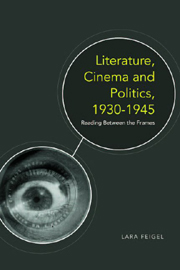Book contents
- Frontmatter
- Contents
- Acknowledgements
- List of Figures
- Introduction
- 1 Radical Cinema
- 2 Mass Observing: The 1930s Documentary Gaze
- 3 The Documentary Movement and Mass Leisure, 1930–1945
- 4 Camera Consciousness
- 5 Framing History: Virginia Woolf and the Politicisation of Aesthetics
- 6 ‘The savage and austere light of a burning world’: The Cinematic Blitz
- Afterword
- Endnotes
- Bibliography
- Index
Afterword
Published online by Cambridge University Press: 12 September 2012
- Frontmatter
- Contents
- Acknowledgements
- List of Figures
- Introduction
- 1 Radical Cinema
- 2 Mass Observing: The 1930s Documentary Gaze
- 3 The Documentary Movement and Mass Leisure, 1930–1945
- 4 Camera Consciousness
- 5 Framing History: Virginia Woolf and the Politicisation of Aesthetics
- 6 ‘The savage and austere light of a burning world’: The Cinematic Blitz
- Afterword
- Endnotes
- Bibliography
- Index
Summary
Victory Bonfire
On 7 May 1945, London was again in flames. William Sansom watched apprehensively as the citizens celebrated ‘joy, the fireworks of victory, the bonfires and songs of deliverance’. Those Londoners who had urged on the Nazi fires in their destruction could now legitimately kindle their own victory bonfires. As in the days of the Blitz, the small fires spread, until each ‘cast its coppery glow on the house-rows, on glassy windows and the black blind spaces where windows once had been’ (p. 201). Higher up, the sky blazed with fireworks – a curious luxury for a nation that had cowered from the explosions of the bombs and the rattle of the guns. And of course, as the fire reignited memories of wartime conflagration, it also awakened the ghosts of the dead. ‘The ghosts of wardens and fire-guards and firemen were felt scurrying again down in the redness.’
These fires were built on the wreckage of other fires, not just in Britain but throughout Europe. The British had valiantly survived the air war. But the German ruins would be harder to rebuild, their dead too many to commemorate. And as well as the ashes in Dresden or Hamburg, there were the even less thinkable vestiges of the bodies systematically burned in the Nazi gas ovens.
- Type
- Chapter
- Information
- Literature Cinema and Politics 1930–1945Reading Between the Frames, pp. 232 - 236Publisher: Edinburgh University PressPrint publication year: 2010

